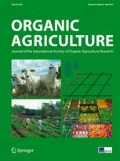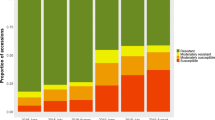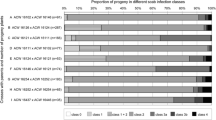Abstract
Apple scab and powdery mildew are the two most destructive fungal diseases of apple, especially in organic orchards, where synthetic pesticides are prohibited. Only a limited choice of natural substances for control of pests and diseases allowed to be used. Growing resistant/tolerant cultivars can highly reduce the number of the necessary plant protection treatments resulting in lower costs and environmental impact. Besides the newly developed cultivars, several old apple cultivars are thought to be resistant/tolerant to the main fungal diseases of apple; however, in most cases, the degree and type of their resistance is not well characterized. To evaluate the resistance of ten old cultivars against apple scab and powdery mildew, field evaluations were carried out for 6 years. Molecular marker analysis was also carried out: six different markers were used for the detection of three major scab resistance genes (Vf, Vh4, Vh2). The resistance gene Vf could not be found in any old cultivar while the resistance genes Vh2, Vh4 are possibly present in several cultivars. The results are explaining the good disease tolerance of several cultivars (e.g., ‘Batul’), and also suggest their relevance in the breeding as well as in organic farming. Some old cultivars showed good field resistance against fungal diseases, even though their resistance against scab could not be explained with the presence of the investigated major scab resistance genes. This suggests that a few cultivars might possess polygenic resistance, or maybe new major scab resistance genes.
Similar content being viewed by others
References
Bálint J, Thiesz R, Nyárádi II, Szabó KA (2013) Field evaluation of traditional apple cultivars to induced diseases and pests. Notulae Botanicae Horti Agrobotanici 41(1):238–243
Boudichevskaia A, Flachowsky H, Peil A, Fischer C, Dunemann F (2006) Development of a multiallelic SCAR marker for the scab resistance gene Vr1/Vh4/Vx from R12740-7A apple and its utility for molecular breeding. Tree Genet Genomes 2:186–195
Broggini G, Bus V, Parravicini G, Kumar S, Groenwold R, Gessler C (2011) Genetic mapping of 14 avirulence genes in an EU-B04 × 1639 progeny of Venturia inaequalis. Fungal Genet Biol 48:166–176
Bus VGM, Alspach PA, Hofstee ME, Brewer LR (2002) Genetic variability and preliminary heritability estimates of resistance to scab (Venturia inaequalis) in an apple genetics population. N Z J Crop Hortic Sci 30:83–92
Bus VGM, Rikkerink EHA, Weg WE, Rusholme RL, Gardiner SE, Bassett HCM, Kodde LP, Parisi L, Laurens FND, Meulenbroek EJ, Plummer KM (2005) The Vh2 and Vh4 scab resistance genes in two differential hosts derived from Russian apple R12740-7A map to the same linkage group of apple. Mol Breed 15:103–116
Bus V, Rikkerink E, Aldwinckle HS, Caffier V, Durel CE, Gardiner S, Gessler C, Groenwold R, Laurens F, Le Cam B (2009) A proposal for the nomenclature of Venturia inaequalis races. Acta Horticult 814:739–746
Cova V, Lasserre-Zuber P, Piazza S, Cestaro A, Velasco R, Durel CE, Malnoy M (2015) High-resolution genetic and physical map of the Rvi1 (Vg) apple scab resistance locus. Mol Breed 35:16. doi:10.1007/s11032-015-0245-1
Gessler C, Patocchi A, Sansavini S, Tartarini S, Gianfranceschi L (2006) Venturia inaequalis resistance in apple. Crit Rev Plant Sci 25:473–503
Holb IJ, Heijne B, Withagen JCM, Gáll JM, Jeger MJ (2005) Analysis of summer epidemic progress of apple scab at different apple production systems in the Netherlands and Hungary. Ecol Epidemiol 95(9):1001–1020
Kellerhals M, Duffy B (2006) In: Boos M (ed) Use of genetic resources and partial resistances for apple breeding. [Nutzen von Genressourcen und Teilresistenzen in der Apfelzüchtung.]. Ecofruit - 12th International Conference on Cultivation Technique and Phytopathological Problems in Organic Fruit-Growing: Proceedings to the Conference from 31st January to 2nd February 2006, Weinsberg, pp 157–160
Kellerhals M, Duffy B, Nybom H, Ahmadi-Afzadi M, Höfer M, Richter K, Lateur M (2012) European pome fruit genetic resources evaluated for disease resistance. Trees 26:179–189. doi:10.1007/s00468-011-0660-9
Kumar S, Bink MCAM, Volz RK, Bus VGM, Chagné D (2011) Towards genomic selection in apple (Malus × domestica Borkh.) breeding programmes: prospects, challenges and strategies. Tree Genet Genomes 8:1–14
Lateur M, Populer C (1994) Screening fruit tree genetic resources in Belgium for disease resistance and other desirable characters. Euphytica 77(1–2):147–153
MacHardy WE (1996) Apple scab, biology, epidemiology and management. APS Press, Minnesota, 545 pp
Nagy-Tóth F (1998) Régi erdélyi almafajták. Erdélyi Múzeum-Egyesület, Kolozsvár
Padmarasu S, Sargent DJ, Jaensch M, Kellerhals M, Tartarini S, Velasco R, Troggio M, Patocchi A (2014) Fine-mapping of the apple scab resistance locus Rvi12 (Vb) derived from ‘Hansen’s baccata #2’. Mol Breed 34:2119–2129. doi:10.1007/s11032-014-0167-3
Papp D, Ficzek G, Stégern MM, Nótin B, Király I, Tóth M (2011) Kárpát-medencei régi almafajták beltartalmi értékei és perspektívái a XX. század hazai gyümölcsnemesítésében. Kertgazdaság 40(1):23–27
Papp D, Zs B, Balotai B, Tóth M (2015) Identification of marker alleles linked to fire blight resistance QTLs in apple genotypes. Plant Breed. doi:10.1111/pbr.12258
Parisi L, Lespinasse Y, Guillaumès J, Krüger J (1993) A new race of Venturia inaequalis virulent to apples with resistance due to the Vf gene. Phytopathology 93:533–537
Patocchi A, Frei A, Frey JE, Kellerhals M (2009) Towards improvement of marker assisted selection of apple scab resistant cultivars: Venturia inaequalis virulence surveys and standardization of molecular marker alleles associated with resistance genes. Mol Breed 24:337–347
Patrascu B, Pamfil D, Sestras R, Botez C, Gaboreanu I, Bărbos A, Qin C, Rusu R, Bondrea I, Dîrle E (2006) Marker assisted selection for response attack of Venturia inaequalis in different apple genotypes. Notulae Botanicae Horti Agrobotanici Cluj-Napoca 34:121–133
Patzak J, Paprstein F, Henychová A (2011) Identification of apple scab and powdery mildew resistance genes in Czech apple (Malus × domestica) genetic resources by PCR molecular markers. Czech J Genet Plant Breed 47(4):156–165
Reuveni M, Cohen H, Zahavi T, Venezian A (2000) Polar — a potent Polyoxin B compound for controlling powdery mildews in apple and nectarine trees, and grapevines. Crop Prot 19:393–399
Sierotzki H, Eggenschwiler M, Boillat O, McDermott JM, Gessler C (1994) Detection of variationin virulence toward susceptible apple cultivars in natural populations of Venturia inaequalis. Ecol Epidemiol 84(10):1005–1009
Soriano JM, Joshi SG, Van Kaauwen M, Noordijk Y, Groenwold R, Henken B, Van de Weg WE, Schouten HJ (2009) Identification and mapping of the novel apple scab resistance gene Vd3. Tree Genet Genomes 5:475–482
Tartarini S, Gianfranceschi L, Sansavini S, Gessler C (1999) Development of reliable PCR markers for the selection of the Vf gene conferring scab resistance in apple. Plant Breed 118:183–186
Tóth M, Sz K, Kása K, Zs R, Hevesi M (2004) First selections of the Hungarian apple breeding program for multiple resistance. Int J Horticult Sci 10(3):9–13
Tóth M, Balikó E, Zs S (2005) Evaluation of fruit quality of old apple cultivars originating from the foot of the Carpathian Mountains, for utilization in breeding and in ecological farming. Int J Horticult Sci 11(3):15–21
Tóth M, Ficzek G, Király I, Sz K, Hevesi M, Halász J, Zs S (2012) ‘Artemisz’, ‘Cordelia’, ‘Hesztia’ and ‘Rosmerta’: new Hungarian multiresistant apple cultivars. HortSci 42(2):1795–1800
Urbanovich O, Kazlovskaya Z (2008) Identification of scab resistance genes in apple trees by molecular markers. Scientific works of the Lithuanian university of agriculture. Sodininkyste ir Darzininkyste 27(2):347–357
Acknowledgement
In 2014, The evaluation of the field resistance was carried out in the framework of post-doc research program of the Hungarian Research Institute of Organic Agriculture (ÖMKi).
Author information
Authors and Affiliations
Corresponding author
Rights and permissions
About this article
Cite this article
Papp, D., Király, I. & Tóth, M. Suitability of old apple varieties in organic farming, based on their resistance against apple scab and powdery mildew. Org. Agr. 6, 183–189 (2016). https://doi.org/10.1007/s13165-015-0126-2
Received:
Accepted:
Published:
Issue Date:
DOI: https://doi.org/10.1007/s13165-015-0126-2




